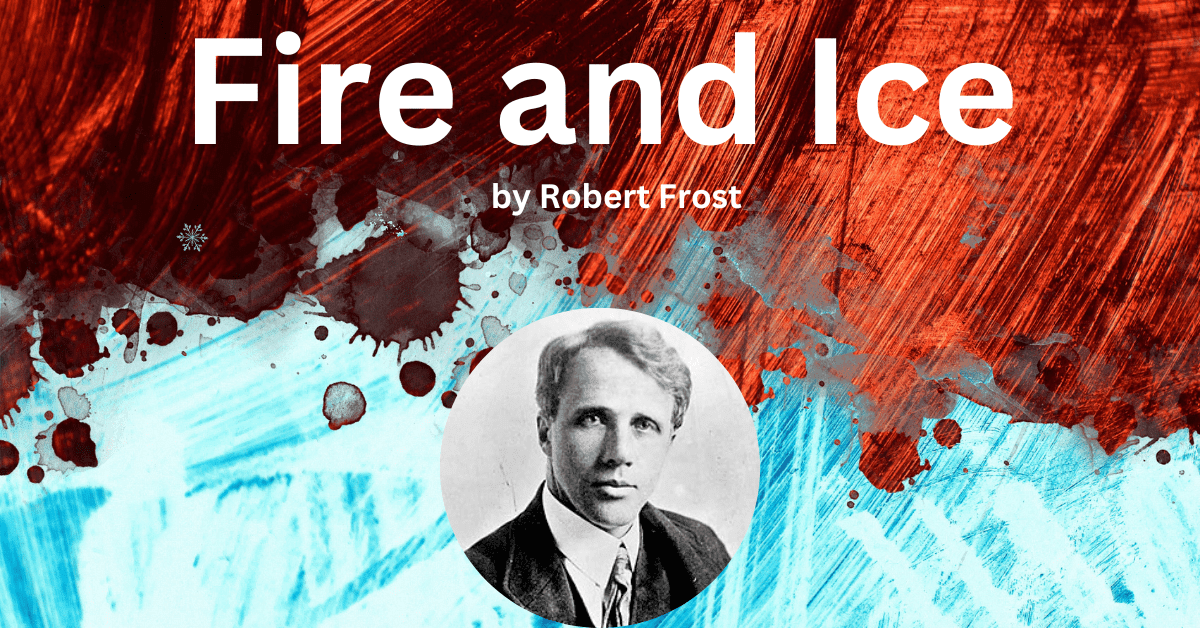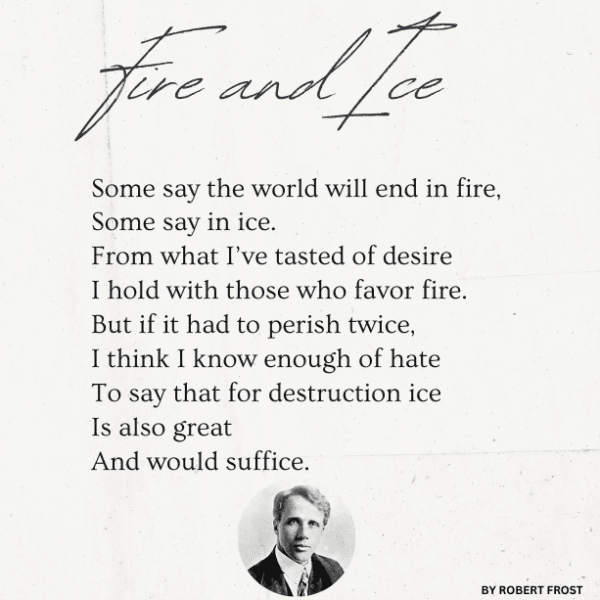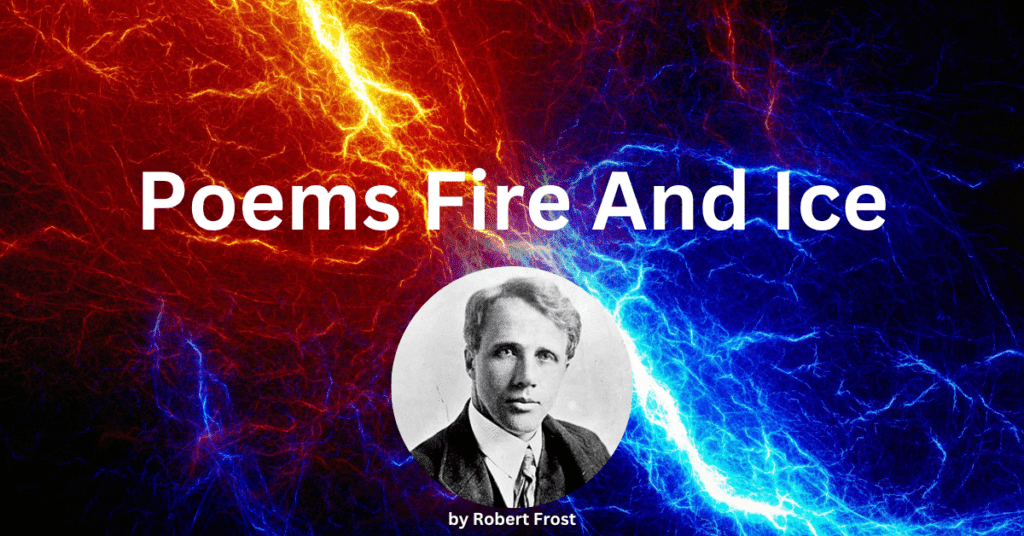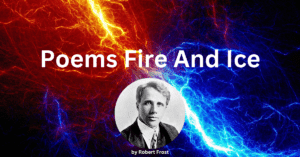
Ice and Fire Poem
Exploring the Power of Desire and Destruction
Updated: October 2025
Few poems have captured the extremes of human emotion as elegantly as Robert Frost’s “Fire and Ice.”
In just nine lines, Frost turns two elemental forces—fire and ice—into timeless symbols of passion, hatred, and the fragile balance between them. The poem invites readers to reflect on what truly drives the end of worlds, both literal and emotional: the burning heat of desire or the numbing chill of indifference.
But beneath its simplicity lies a profound philosophical question: Is it passion or apathy that ultimately destroys us?
In this analysis, we’ll explore the deeper meaning of “Fire and Ice,” uncovering how Frost uses vivid imagery, rhythm, and contrast to reveal eternal truths about love, hate, and the human condition.
The Poem: Fire and Ice
By Robert Frost
Some say the world will end in fire,
Some say in ice.
From what I’ve tasted of desire
I hold with those who favor fire.
But if it had to perish twice,
I think I know enough of hate
To say that for destruction ice
Is also great
And would suffice.
Understanding the Meaning of “Fire and Ice”
🔥 Fire as a Symbol of Desire
In Frost’s universe, fire represents the fierce, consuming energy of human desire — passion, ambition, lust, and love. It is the heat of longing that propels people toward creation but can also lead them to ruin.
When Frost writes,
“From what I’ve tasted of desire, I hold with those who favor fire,”
he suggests that passion, though intoxicating, has the potential to burn the world to ashes — a poetic metaphor for how unrestrained emotion can consume relationships, societies, and even the self.
In psychological terms, desire is linked to dopamine-driven impulses — the same forces behind addiction and obsession. It can fuel creativity and connection, but without restraint, it becomes self-destructive.
❄️ Ice as a Symbol of Hate and Indifference
Opposite the burning passion of fire lies the frigid stillness of ice. Frost equates it not simply with hate, but with emotional coldness — the kind that freezes empathy and distances hearts.
“I think I know enough of hate
To say that for destruction ice
Is also great
And would suffice.”
Here, Frost acknowledges that apathy can be just as deadly as passion. Indifference kills slowly; it doesn’t consume, it withers.
In relationships, this manifests as silence, distance, or emotional detachment — a slow erosion rather than a sudden blaze.
A 2018 study in the Journal of Social and Personal Relationships found that emotional neglect in couples often causes more lasting harm than heated conflict. Frost’s ice perfectly captures that truth: a world frozen in hate will perish quietly but completely.
The Dual Nature of Human Emotion
Frost’s brilliance lies in his ability to distill an eternal paradox: both fire and ice live within us. Love and hate, warmth and coldness, desire and indifference — these are not opposites but reflections of the same emotional intensity.
| Symbol | Represents | Emotional Force | Potential Outcome |
|---|---|---|---|
| Fire | Desire, passion, love | Explosive energy | Rapid destruction or creation |
| Ice | Hate, indifference, apathy | Emotional withdrawal | Slow decay or isolation |
In love, we see this contrast daily.
-
Passion fuels connection, but too much burns bridges.
-
Distance preserves calm, but too much freezes affection.
Frost’s poem, though brief, becomes a warning — not against emotion itself, but against imbalance. The world doesn’t end because we feel too much or too little; it ends because we stop mastering what we feel.
Literary Analysis: How Frost Turns Simplicity into Depth
1. Form and Structure
“Fire and Ice” follows a nine-line structure with a tight ABCB rhyme scheme, reflecting Frost’s mastery of brevity.
The short, rhythmic cadence mimics the poem’s theme — destruction that is sudden yet inevitable. The alternating sounds of fire and ice create a verbal duel, echoing the tension between heat and cold, love and hate.
2. Tone and Voice
Frost’s tone is calm, almost conversational. Yet beneath that simplicity lies a chilling detachment — as though the speaker observes human destruction from afar, acknowledging it as both tragic and inevitable.
The neutrality of the voice mirrors the indifference of “ice,” while the rhythm embodies the pulsing energy of “fire.” This duality in tone reflects the poem’s central message: both extremes coexist within the same soul.
3. Imagery and Symbolism
Frost’s use of elemental imagery makes his message universal. Fire and ice are not abstract symbols; they’re tangible, familiar, and timeless. By using nature’s forces, he connects human emotion to cosmic destruction, showing that personal feelings and global catastrophe share the same essence — imbalance.
The Psychology Behind “Fire and Ice”
🧠 Why Passion and Hate Feel the Same
Modern neuroscience supports Frost’s intuition: love and hate are biologically intertwined.
According to a study by University College London, both emotions activate the same regions in the brain — particularly the putamen and insula — responsible for intense emotional response.
This means that the same energy that fuels romance can also power resentment. Frost, writing a century ago, captured this duality before science confirmed it.
Poetic truth: The fire that warms can also destroy; the ice that cools can also kill.
How to Apply Frost’s Lesson in Modern Love
Frost’s poem isn’t just literary brilliance — it’s emotional wisdom disguised as verse.
Here’s how his insight applies to relationships today:
❤️ 1. Balance Passion with Patience
Let your emotions inspire you, not consume you. Intense love is beautiful, but without boundaries, it burns out quickly.
💬 2. Avoid the Freeze of Indifference
Silence, neglect, or emotional withdrawal can end relationships long before words do. Keep warmth alive through communication and care.
🌗 3. Recognize the Fire and Ice Within
Self-awareness is the antidote to destruction. Knowing when you’re acting out of passion or apathy helps you restore balance before harm occurs.
Comparison: Romantic Poetry vs. Frost’s Realism
| Aspect | Romantic Poetry | Frost’s “Fire and Ice” |
|---|---|---|
| Tone | Idealistic, emotional | Reflective, restrained |
| Theme | Eternal love and beauty | Emotional destruction and balance |
| Purpose | To celebrate love | To analyze human nature |
| Emotion | Overflowing and passionate | Controlled yet intense |
| Impact | Inspires longing | Provokes reflection |
While Romantic poets like Byron and Shelley glorified passion, Frost offers something more sobering: a reminder that love’s intensity, unchecked, can lead to ruin. His realism makes his poem not only artful but enduringly relevant.
FAQs
1. What is the main theme of “Fire and Ice”?
The poem explores the destructive power of human emotions — specifically, desire (fire) and hate (ice) — and how both can bring about the end of the world.
2. Why did Robert Frost write this poem?
Frost wrote it in 1920 after World War I, reflecting on human tendencies toward both passion and apathy. It was also inspired by contemporary discussions about cosmic destruction and moral decay.
3. Is the poem about literal destruction?
Not necessarily. It’s a metaphor for emotional and moral collapse — how internal forces like greed, anger, and indifference can lead to downfall.
4. What literary devices does Frost use?
He employs symbolism, contrast, irony, and understatement, allowing a short poem to carry immense philosophical weight.
5. How does “Fire and Ice” connect to love and relationships?
It reveals that both excessive passion and emotional coldness can destroy relationships — reminding us that balance sustains love.
Conclusion: Fire, Ice, and the Fragile Heart
In “Fire and Ice,” Robert Frost captures the eternal truth of love and humanity: we are both creators and destroyers of our own worlds. Our emotions, like fire and ice, hold the power to illuminate or extinguish.
Love burns bright when nurtured — but left unchecked, it consumes. Hate chills when ignored — but faced with empathy, it melts.
So perhaps Frost’s message is not about how the world will end, but how it can be saved:
through awareness, balance, and the courage to feel without letting feeling destroy.
💞 Explore More Deep Love Poetry
Discover more analyses and romantic reflections at DeepLovePoems.com:
-
I Thank God For You – True Love Poems From the Heart
-
Everything for You – Deep Love Poems
-
Days Are So Long – Deep Love Poems









